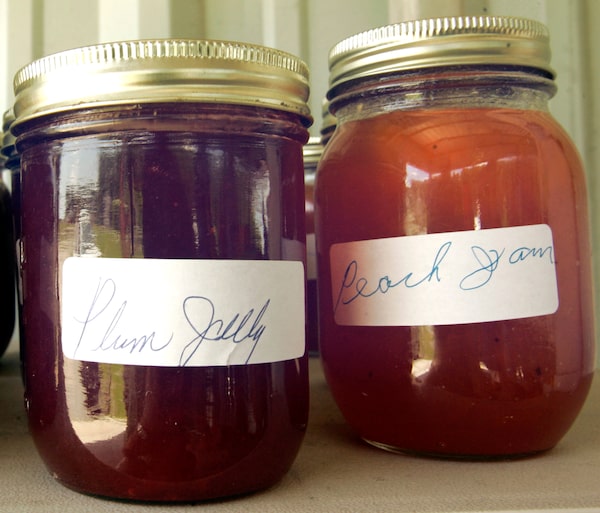
Homemade jams and jellies are displayed at Holland Bottom Farms roadside stand near Cabot, Ark., in this file photo.Danny Johnston/AP
Local summer fruit is glorious. It tastes incredible eaten out of hand, and cooks beautifully, making summer desserts that are naturally sweet and satisfying. But for me, summer fruit is synonymous with jam. I make many different kinds and look lovingly at them until fall, when I open them up to relive those marvellous tastes.
Jam is easy to make and these tips will help you produce wonderful preserves.
Pectin is a natural gelling agent found in the skins/peels and seeds of fruit. I do not like using store-bought pectin. It makes jams taste dull. Instead, I add high-pectin citrus, such as lemon or lime juice, or use a high-pectin fruit along with one that is low. A great combination is strawberry and grated apple, or raspberry and lime. My other, easier solution: Add half a grated tart apple with skin to 4 cups of fruit.
Use underripe fruit, if possible, as it contains more acid and will set better. Lemon or lime juice will help with setting and will also offer pectin. Squeeze the juice of a lemon into 6 cups of chopped fruit. Sometimes I also thinly slice a lime or lemon and add to the uncooked mixture. When the jam is cooked and cooled, I chop up the slices and return them.
Keep the sugar down. Old recipes call for equal amounts of sugar and fruit. Today a ratio of 150 to 200 grams of sugar to 300 grams fruit (about 1 cup of sugar to every 2 cups of fruit) works, but bear in mind it will be a softer set.
Use a wide pan with a heavy base and heat the sugar and fruit together gently until the sugar dissolves, then turn up the heat to high. Boil the jam, stirring occasionally. Skim the foam with a slotted spoon, then stir in about 1 tbsp butter, which helps to remove any residue. Jam sets at 220 F (105 C). A good thermometer saves time and failure. If you don’t have one, chill some saucers and drizzle over a spoonful of jam when you think it is set. You’ll know the jam has set if the sides crinkle when you draw a knife through it.
Let the jam sit for 20 minutes, then ladle into the warm jars, filling to just below the top. As I am essentially lazy, I put my jars through the dishwasher without soap and fill them while they are still warm, instead of sterilizing them in a hot water bath. Once full, screw on the lid and refrigerate. I keep them refrigerated for up to a year.
There are many options for flavouring jam, so be imaginative. Ginger, rosemary, thyme, pepper, chili, star anise and sage all add a different dimension. Add these ingredients if you like with the sugar and fruit before cooking. For another take, add liqueurs or spirits to each individual jar.
To finish, label with the name of the jam and the year. This takes the surprise out of opening your jars.
A recipe for homemade pectin
You can make your own pectin. Slowly simmer a large bottle of apple cider, preferably organic, on the stove until it becomes jelly-like, about 1 1/2 hours (220 F on an instant read thermometer). The result: apple jelly or pectin. I add about 2 tbsp of homemade pectin to 3 cups of fruit, if the fruit is low in pectin, as an alternative to lemon juice or grated apple.
Need some advice about kitchen life and entertaining? Send your questions to lwaverman@globeandmail.com.